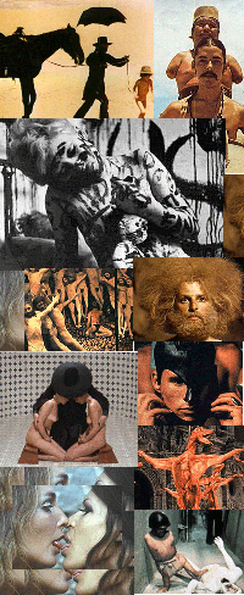Cinema for Initiates

In 1967, Jodorowsky adapted for the screen ‘Fando Y Lis’, the semi-autobiographical play by Fernando Arrabal in which a teenager offers his girlfriend to sexually perverse beings, within a wasted landscape reminiscent of something from the imagination of Beckett and Buñuel. The film’s presentation was stalled by government censors, but its eventual premiere at the Acapulco Festival in 1968 was one of the heightened moments of tension between the new emerging culture and the conservative forces of Mexican society.
Barely one year later Jodorowsky took his panic fable to the screen, though made into a Western: El Topo (The Mole). This tale is about an eccentric enlightenment gave Jodorowsky an iconic status in the emergent international counterculture. As a matter of fact, the concept of the ‘cult movie’ was first used in reference to El Topo, in order to describe the devout, psychotropic and mysterious experience surrounding the midnight showing of the film during a run at New York’s Elgin Theatre that went on for over twelve months. The ‘Midnight Mass at the Elgin,’ as Glen O’Brian of the Village Voice called it, led Jodorowsky to the Beatles’ producer, Allen Klein of ABKCO, who encouraged by John Lennon, Yoko Ono & George Harrison, decided to fund a movie directed by Jodorowsky, underground but with Hollywood production values.
That is how he made The Holy Mountain of 1973, a film that goes beyond telling a story of mystical experience to present a mise-en-scène of an effective initiation. Jodorowsky placed before the camera a barbaric collage with self-administered spiritual exercise derived from all kinds of traditions, although basically they were drawn from the Arica Method of numerical symbology developed by one of Gurdjieff’s disciples, Oscar Ichazo and pervaded by a mystical vision (very much in Artaud’s footsteps) of the American indigenous world. Under this mantle of esoteric terminology, The Holy Mountain presented a visually overloaded response to the violent government actions of 1968, and to the terrors arising in an era ruled by capitalism and militarism, alluding as explicitly as was possible to the killing of students, and to corporate control over daily life. This film marks a peak in the countercultural ambition to propose a critique of society as a totality, searching for weapons outside enlightened Western traditions.
- By Olivier Debroise, Universidad Nacional Autónoma de México
Barely one year later Jodorowsky took his panic fable to the screen, though made into a Western: El Topo (The Mole). This tale is about an eccentric enlightenment gave Jodorowsky an iconic status in the emergent international counterculture. As a matter of fact, the concept of the ‘cult movie’ was first used in reference to El Topo, in order to describe the devout, psychotropic and mysterious experience surrounding the midnight showing of the film during a run at New York’s Elgin Theatre that went on for over twelve months. The ‘Midnight Mass at the Elgin,’ as Glen O’Brian of the Village Voice called it, led Jodorowsky to the Beatles’ producer, Allen Klein of ABKCO, who encouraged by John Lennon, Yoko Ono & George Harrison, decided to fund a movie directed by Jodorowsky, underground but with Hollywood production values.
That is how he made The Holy Mountain of 1973, a film that goes beyond telling a story of mystical experience to present a mise-en-scène of an effective initiation. Jodorowsky placed before the camera a barbaric collage with self-administered spiritual exercise derived from all kinds of traditions, although basically they were drawn from the Arica Method of numerical symbology developed by one of Gurdjieff’s disciples, Oscar Ichazo and pervaded by a mystical vision (very much in Artaud’s footsteps) of the American indigenous world. Under this mantle of esoteric terminology, The Holy Mountain presented a visually overloaded response to the violent government actions of 1968, and to the terrors arising in an era ruled by capitalism and militarism, alluding as explicitly as was possible to the killing of students, and to corporate control over daily life. This film marks a peak in the countercultural ambition to propose a critique of society as a totality, searching for weapons outside enlightened Western traditions.
- By Olivier Debroise, Universidad Nacional Autónoma de México

